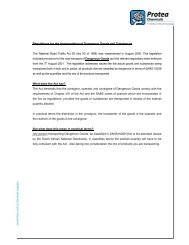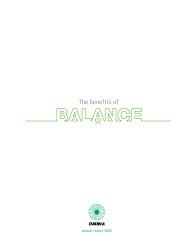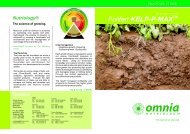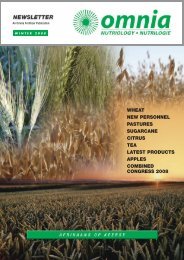omnia holdings annual report 2010 omnia holdings annu
omnia holdings annual report 2010 omnia holdings annu
omnia holdings annual report 2010 omnia holdings annu
Create successful ePaper yourself
Turn your PDF publications into a flip-book with our unique Google optimized e-Paper software.
1.5 Cost of sales<br />
When inventories are sold, the carrying amount of those<br />
inventories is recognised as an expense in the period in which<br />
the related revenue is recognised. The amount of any writedown<br />
of inventories to net realisable value and all losses of<br />
inventories are recognised as an expense in the period in which<br />
the write-down or loss occurs.<br />
Other Accounting Policies<br />
1.6 Basis of consolidation<br />
Group financial statements include those of Omnia Holdings<br />
Limited and its subsidiaries, joint ventures and associates.<br />
1.6.1 Subsidiaries<br />
Subsidiary undertakings (including special purpose entities),<br />
which are those companies in which the Group, directly or<br />
indirectly, has an interest of more than half of the voting rights,<br />
or otherwise has power to exercise control over the financial and<br />
operating policies, have been consolidated. The existence and<br />
effect of potential voting rights that are currently exercisable or<br />
convertible are considered when assessing whether the Group<br />
controls another entity. Subsidiaries are fully consolidated from<br />
the date on which control is transferred to the Group.<br />
Subsidiaries are no longer consolidated from the date that<br />
control ceases.<br />
The purchase method of accounting is used to account for<br />
the acquisition of subsidiaries by the Group. The cost of the<br />
acquisition is measured at the fair value of the assets given,<br />
equity instruments issued and liabilities incurred or assumed<br />
at the date of exchange, plus costs directly attributable to<br />
the acquisition. Identifiable assets and liabilities acquired and<br />
contingent liabilities assumed in a business combination are<br />
measured initially at their fair values at the acquisition date,<br />
irrespective of the extent of any minority interest. The<br />
excess of the cost of acquisition over the fair value of the<br />
Group’s share of the identifiable net assets acquired is<br />
recorded as goodwill. If the cost of acquisition is less than<br />
the fair value of the net assets of the subsidiary acquired,<br />
the difference is recognised directly in the income<br />
statement. Refer to note 1.7.1 for the accounting treatment<br />
of goodwill. All intercompany transactions, balances and<br />
unrealised surpluses or deficits on transactions between<br />
Group companies are eliminated. Unrealised losses are also<br />
eliminated.<br />
Subsidiaries’ accounting policies have been changed where<br />
necessary to ensure consistency with the policies adopted by<br />
the Group.<br />
The Group’s subsidiaries domiciled in Mali, Mauritania and<br />
Senegal have December year ends as required by the respective<br />
authorities.<br />
The Group applies a policy of treating transactions with minority<br />
interests as transactions with equity owners of the Group. For<br />
purchases from non-controlling interests, the difference<br />
between any consideration paid and the relevant share acquired<br />
of the carrying value of the net assets of the subsidiary is<br />
recorded in equity. Gains or losses on disposals to noncontrolling<br />
interests are also recorded in equity.<br />
OMNIA ANNUAL REPORT <strong>2010</strong> 81<br />
1.6.2 Joint ventures<br />
The Group’s interests in jointly controlled entities are accounted<br />
for by proportionate consolidation.<br />
The Group combines its share of the joint ventures’ individual<br />
income and expenses, assets and liabilities and cash flows on a<br />
line-by-line basis with similar items in the Group’s financial<br />
statements.<br />
The Group recognises the portion of gains or losses on the sale<br />
of assets by the Group to the joint venture that is attributable to<br />
other venturers. The Group does not recognise its share of<br />
profits or losses from the joint venture that result from the<br />
Group’s purchase of assets from the joint venture until it resells<br />
the assets to an independent party. A loss on the transaction is<br />
recognised immediately if it provides evidence of a reduction in<br />
the net realisable value of current assets, or an impairment loss.<br />
Joint ventures’ accounting policies have been changed where<br />
necessary to ensure consistency with the policies adopted by<br />
the Group.<br />
1.6.3 Associates<br />
Associates are all entities over which the Group has significant<br />
influence but not control, generally accompanying a shareholding<br />
of between 20% and 50% of the voting rights. Investments in<br />
associates are accounted for using the equity method of<br />
accounting and are initially recognised at cost. The Group’s<br />
investment in associates includes goodwill (net of any<br />
accumulated impairment loss) identified on acquisition.<br />
The Group’s share of its associates’ post-acquisition profits or<br />
losses is recognised in the income statement, and its share of<br />
post-acquisition movement in reserves is recognised in reserves.<br />
The cumulative post-acquisition movements are adjusted against<br />
the carrying amount of the investment. When the Group’s share<br />
of losses in an associate equals or exceeds its interest in the<br />
associate, including any other unsecured receivables, the Group<br />
does not recognise further losses, unless it has incurred<br />
obligations or made payments on behalf of the associate.<br />
Unrealised gains on transactions between the Group and its<br />
associates are eliminated to the extent of the Group’s interest in<br />
the associates. Unrealised losses are also eliminated unless the<br />
transaction provides evidence of an impairment of the asset<br />
transferred. Accounting policies of associates have been<br />
changed where necessary to ensure consistency with the<br />
policies adopted by the Group.<br />
The Group’s associate, Nalco Africa, has a December year end to<br />
coincide with Nalco Company in the United States of America.<br />
1.7 Intangible assets<br />
1.7.1 Goodwill<br />
Goodwill represents the excess of the cost of an acquisition<br />
over the fair value of the Group’s share of the net identifiable<br />
assets of the acquired subsidiary/associate at the date of the<br />
acquisition. Goodwill on acquisitions of subsidiaries is included in<br />
intangible assets. Goodwill on acquisition of associates is<br />
included in investments in associates and is tested for<br />
impairment as part of the overall balance. Goodwill is tested<br />
<strong><strong>annu</strong>al</strong>ly on 30 September for impairment and whenever events<br />
or circumstances indicate that the carrying value may not be














